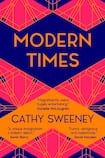
Cleaned up for an infant audience, fairy tales have a seamy history. Is the stepmother wicked or really the mother? Is the king who wanted to marry his daughter mad or sane? Nobody rescued Little Red Riding Hood? Did you hear what happened to Sleeping Beauty after she went off with the prince? Who is the wolf anyway?
In its sparseness, astonishments, and cyclical twists, the fairy tale has something in common with the 20th-century European absurd, which follows funny, appalling patterns of repetition. Cathy Sweeney brings together these two traditions in her brilliant debut short story collection, Modern Times.
In addition to the classic beginning, several of the tales bear variants: “there once was”; “this story is set back in the days when”; “not long ago”. Locations are archetypal (“the palace,” “the forest”) yet include recent points of civilisational orientation: “boarding school,” “the colonies.” Proper names feel like shards from a larger context. Places are generic even when definite: “a cottage in Wales”; “Dublin 4”. As in the fairy tale, supernatural physical transformations cover for psychological states. At the same time, the objects to which the characters are attached inhabit both the primitive-magical and the sexual sense of fetish.
Of recent Irish writing, Modern Times is most similar to the work of Nicole Flattery, whose abstract narratives make the contemporary predicament of being young (mostly a young woman) resemble the reflexes of an automated toy. Sweeney writes from the far side of experience, which is why the stories incorporate the impression of having witnessed their own content before: “I am tired of people with their dot-to-dot fantasies” complains one narrator; “when it is too late we all want to tell the whole story” intones another; “since people always want to know how things end, I’ll tell you” announces a third, ready to produce only the flicker of a happy finale.
Humour in jadedness
The power of storytelling itself comes to be questioned by this worldliness: a narrator wonders why he undergoes emotions not relevant to his life on reading someone else’s testimony, although he has lost exactly what they have lost, without knowing it. If the fairy tale confronts familial and social conflicts, and the modern absurd deals with existential and political dread, Sweeney’s aesthetic focuses on the predictable collision of ordinary human frailty with circumstance. Much of its humour comes from this summarising jadedness: “You know how it is. The economy collapsed, the state broadcaster turned all staff positions into freelance ones, and before he knew it, he was scrabbling for commercials, drinking heavily and posting tweets late at night.”
There are recurring motifs, sometimes in the same tale: marriage and the aftermath of its dissolution; lost loves and the search for a sexual adventure that could be all-consuming, worthless, or a dubious keepsake; creativity, oddly destructively separate from the life it’s supposed to fulfil; child-rearing as a derailing which makes a nonsense even of stoicism; women’s subjection to punishing public scrutiny; narcissism, male and female.
The simplicity of the language prepares moments of dazzle: “I particularly liked the way the countryside blacked out at night, except for tiny stars, sprinkled like sugar, all over the sky.” In the most superb piece of the collection, Alexander the Great plays a briefly stunning, illustrative part, “his death helixing back through all the events of his life”. Characters receive devastating descriptions: “a short man with a compulsion to oppress things that were already oppressed”; a murdered muse has “gulag eyes”.
Barbarous elements
Sweeney’s is not an emancipatory rewriting of the tale of enchantment, but a brush with its barbarous elements. She prises the disturbing out from its disappearance into culture. An already disquieting evocation of the idealized clay image of Ancient Greek pederasty reverberates in a later, drolly matter-of-fact and eerie account of a female teacher’s seduction of a pupil “in a school for adolescents with learning difficulties”. This scenario finds a further echo in the final narrator’s boast about “scoring guys in the dud class for fun”.
Predation lurks in unexpected quarters, as does desire. A woman fleetingly fantasizing about a visiting handyman “realises that she hasn’t really been thinking about him at all” when she sees “the look in his eye, like a dog that has suddenly turned into a wolf”. An overt rewriting of the fairy tale form, A New Story Told out of an Old Story, peels back layers of distortion about a grandmother’s encounter with that prototypical animal in her dissatisfied youth.
As these resonances suggest, Sweeney’s collection has an interlocking force. It also maintains a gathering momentum. Most of the stories recount a woman’s biography from an external perspective, or are told by a negligent male. Halfway through, a narrative voice gendered female emerges. On occasion, the shorter, vignette-like pieces can seem too easily decodable, or heavily tied to a single meaning, however general. But the final two first-person tales are acts of startling characterological ventriloquism, of women immured no less than the men from what narration reveals. They are an appropriately virtuoso conclusion to the whole series. The last, White, rich in detail, unusual yet utterly unified in mood and attitude, heralds all that an eagerly awaited novel from Sweeney might do.
Catherine Toal is dean of Bard College, Berlin










